Critical Evaluation of Scientific Management in Contemporary Orgs
VerifiedAdded on 2023/01/16
|5
|1634
|53
Essay
AI Summary
This essay critically evaluates the relevance of scientific management in contemporary organizations. It begins with an introduction to management theory, highlighting the influence of Frederick Taylor's principles, including task specialization, codified rules, worker selection and training, and payment systems. The essay explores the impact of these principles on productivity and efficiency, using examples from companies like McDonald's and Nissan. It also discusses the limitations of scientific management, such as the potential for worker alienation and the need for flexibility and innovation in modern business environments. The essay analyzes the continued application of scientific management in areas like specialized departments and training programs, while acknowledging the need for a balance between extrinsic and intrinsic motivators. It concludes that while scientific management requires some modifications, it remains a fundamental framework that influences contemporary management practices, alongside other theories such as Maslow's hierarchy of needs. The essay is based on the BUMGT1501 Management Principles course assignment requirements.
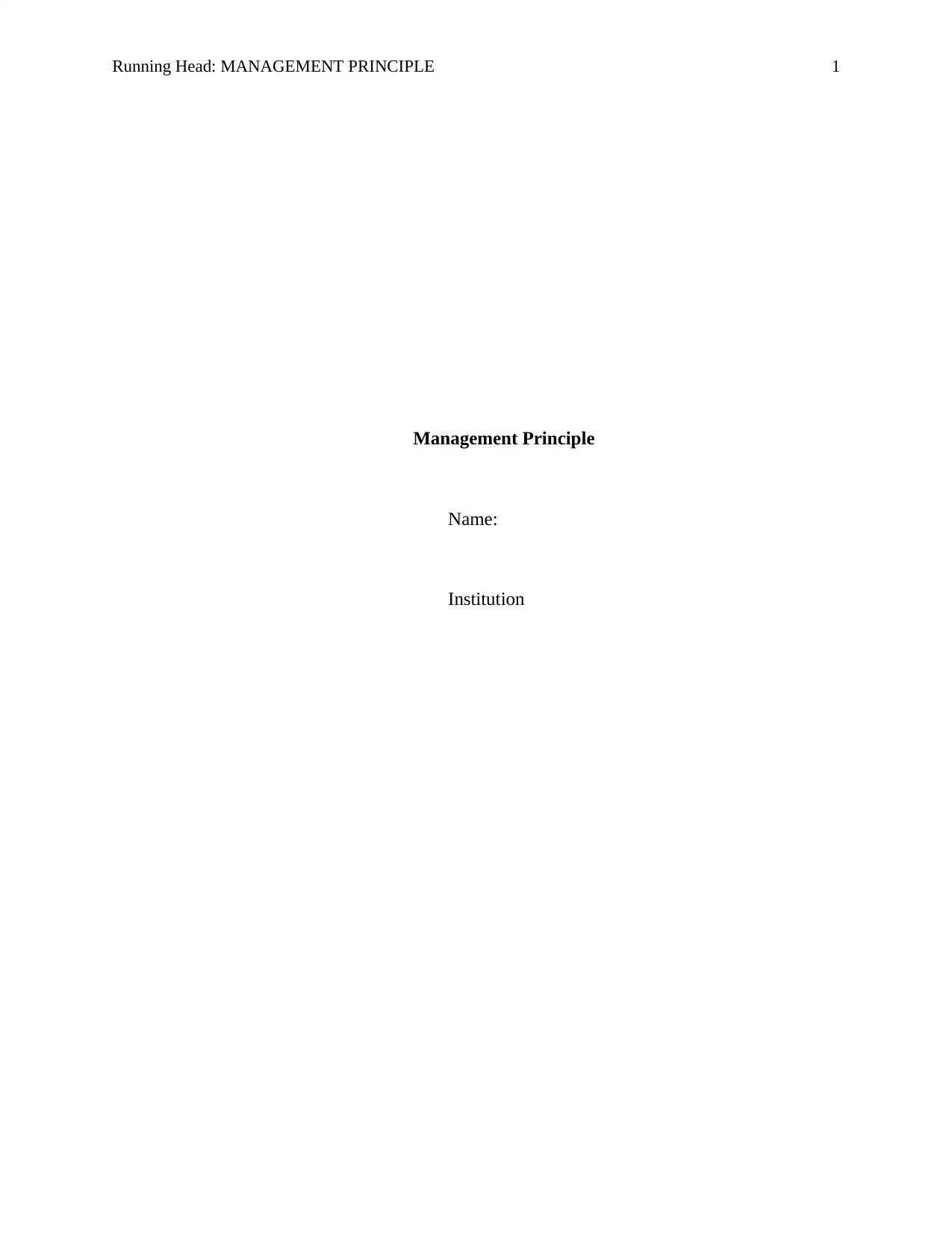
Running Head: MANAGEMENT PRINCIPLE 1
Management Principle
Name:
Institution
Management Principle
Name:
Institution
Paraphrase This Document
Need a fresh take? Get an instant paraphrase of this document with our AI Paraphraser
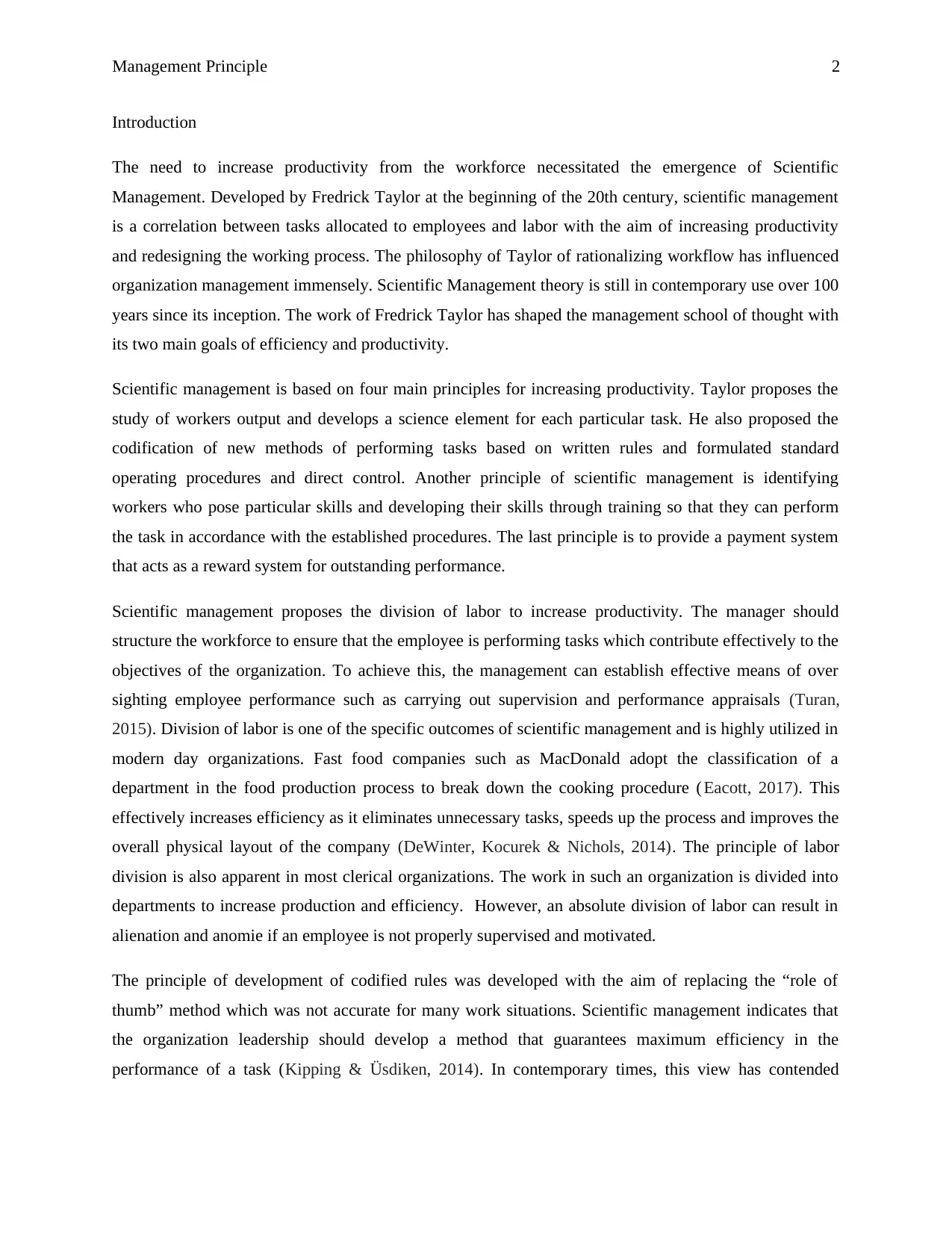
Management Principle 2
Introduction
The need to increase productivity from the workforce necessitated the emergence of Scientific
Management. Developed by Fredrick Taylor at the beginning of the 20th century, scientific management
is a correlation between tasks allocated to employees and labor with the aim of increasing productivity
and redesigning the working process. The philosophy of Taylor of rationalizing workflow has influenced
organization management immensely. Scientific Management theory is still in contemporary use over 100
years since its inception. The work of Fredrick Taylor has shaped the management school of thought with
its two main goals of efficiency and productivity.
Scientific management is based on four main principles for increasing productivity. Taylor proposes the
study of workers output and develops a science element for each particular task. He also proposed the
codification of new methods of performing tasks based on written rules and formulated standard
operating procedures and direct control. Another principle of scientific management is identifying
workers who pose particular skills and developing their skills through training so that they can perform
the task in accordance with the established procedures. The last principle is to provide a payment system
that acts as a reward system for outstanding performance.
Scientific management proposes the division of labor to increase productivity. The manager should
structure the workforce to ensure that the employee is performing tasks which contribute effectively to the
objectives of the organization. To achieve this, the management can establish effective means of over
sighting employee performance such as carrying out supervision and performance appraisals (Turan,
2015). Division of labor is one of the specific outcomes of scientific management and is highly utilized in
modern day organizations. Fast food companies such as MacDonald adopt the classification of a
department in the food production process to break down the cooking procedure ( Eacott, 2017). This
effectively increases efficiency as it eliminates unnecessary tasks, speeds up the process and improves the
overall physical layout of the company (DeWinter, Kocurek & Nichols, 2014). The principle of labor
division is also apparent in most clerical organizations. The work in such an organization is divided into
departments to increase production and efficiency. However, an absolute division of labor can result in
alienation and anomie if an employee is not properly supervised and motivated.
The principle of development of codified rules was developed with the aim of replacing the “role of
thumb” method which was not accurate for many work situations. Scientific management indicates that
the organization leadership should develop a method that guarantees maximum efficiency in the
performance of a task (Kipping & Üsdiken, 2014). In contemporary times, this view has contended
Introduction
The need to increase productivity from the workforce necessitated the emergence of Scientific
Management. Developed by Fredrick Taylor at the beginning of the 20th century, scientific management
is a correlation between tasks allocated to employees and labor with the aim of increasing productivity
and redesigning the working process. The philosophy of Taylor of rationalizing workflow has influenced
organization management immensely. Scientific Management theory is still in contemporary use over 100
years since its inception. The work of Fredrick Taylor has shaped the management school of thought with
its two main goals of efficiency and productivity.
Scientific management is based on four main principles for increasing productivity. Taylor proposes the
study of workers output and develops a science element for each particular task. He also proposed the
codification of new methods of performing tasks based on written rules and formulated standard
operating procedures and direct control. Another principle of scientific management is identifying
workers who pose particular skills and developing their skills through training so that they can perform
the task in accordance with the established procedures. The last principle is to provide a payment system
that acts as a reward system for outstanding performance.
Scientific management proposes the division of labor to increase productivity. The manager should
structure the workforce to ensure that the employee is performing tasks which contribute effectively to the
objectives of the organization. To achieve this, the management can establish effective means of over
sighting employee performance such as carrying out supervision and performance appraisals (Turan,
2015). Division of labor is one of the specific outcomes of scientific management and is highly utilized in
modern day organizations. Fast food companies such as MacDonald adopt the classification of a
department in the food production process to break down the cooking procedure ( Eacott, 2017). This
effectively increases efficiency as it eliminates unnecessary tasks, speeds up the process and improves the
overall physical layout of the company (DeWinter, Kocurek & Nichols, 2014). The principle of labor
division is also apparent in most clerical organizations. The work in such an organization is divided into
departments to increase production and efficiency. However, an absolute division of labor can result in
alienation and anomie if an employee is not properly supervised and motivated.
The principle of development of codified rules was developed with the aim of replacing the “role of
thumb” method which was not accurate for many work situations. Scientific management indicates that
the organization leadership should develop a method that guarantees maximum efficiency in the
performance of a task (Kipping & Üsdiken, 2014). In contemporary times, this view has contended
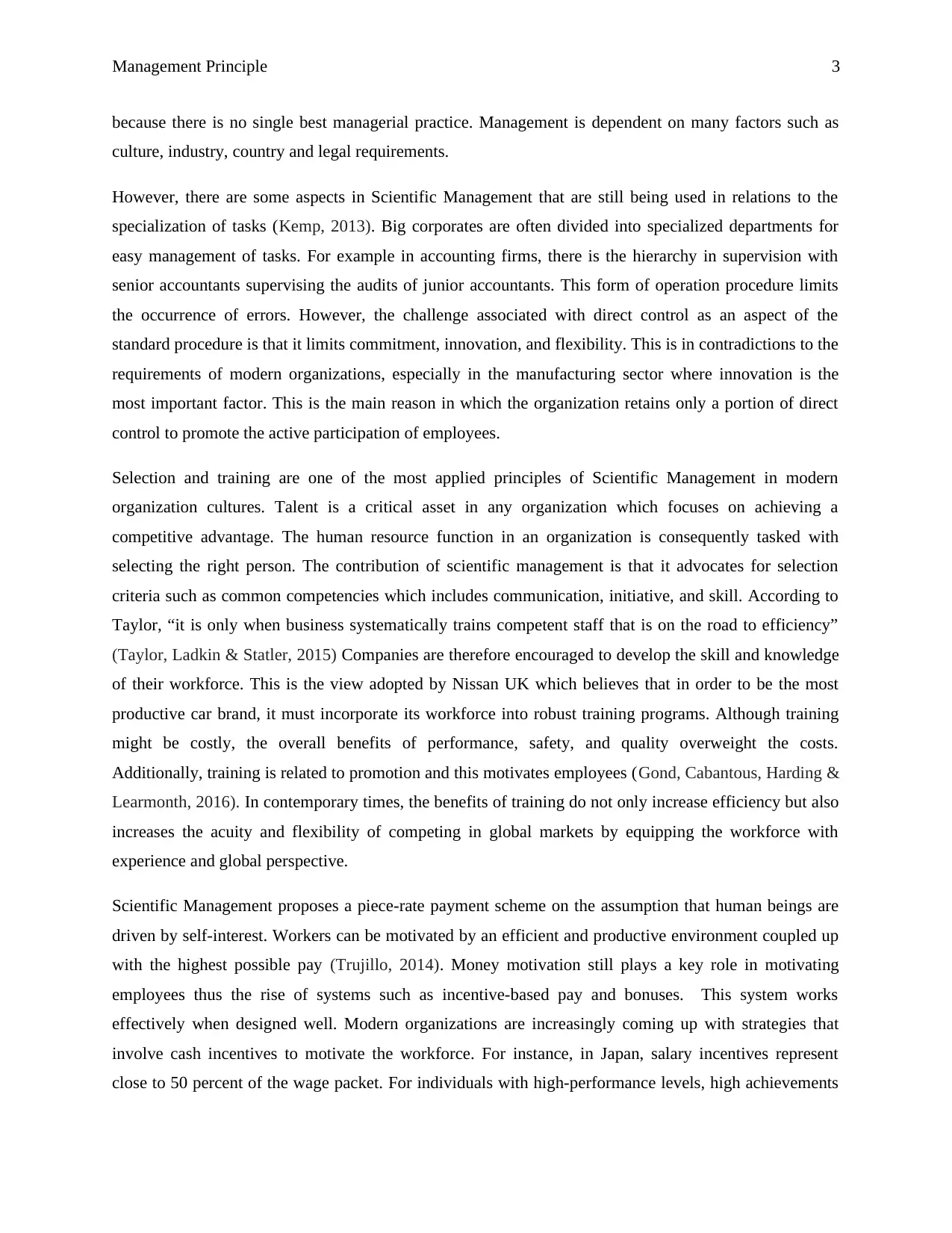
Management Principle 3
because there is no single best managerial practice. Management is dependent on many factors such as
culture, industry, country and legal requirements.
However, there are some aspects in Scientific Management that are still being used in relations to the
specialization of tasks (Kemp, 2013). Big corporates are often divided into specialized departments for
easy management of tasks. For example in accounting firms, there is the hierarchy in supervision with
senior accountants supervising the audits of junior accountants. This form of operation procedure limits
the occurrence of errors. However, the challenge associated with direct control as an aspect of the
standard procedure is that it limits commitment, innovation, and flexibility. This is in contradictions to the
requirements of modern organizations, especially in the manufacturing sector where innovation is the
most important factor. This is the main reason in which the organization retains only a portion of direct
control to promote the active participation of employees.
Selection and training are one of the most applied principles of Scientific Management in modern
organization cultures. Talent is a critical asset in any organization which focuses on achieving a
competitive advantage. The human resource function in an organization is consequently tasked with
selecting the right person. The contribution of scientific management is that it advocates for selection
criteria such as common competencies which includes communication, initiative, and skill. According to
Taylor, “it is only when business systematically trains competent staff that is on the road to efficiency”
(Taylor, Ladkin & Statler, 2015) Companies are therefore encouraged to develop the skill and knowledge
of their workforce. This is the view adopted by Nissan UK which believes that in order to be the most
productive car brand, it must incorporate its workforce into robust training programs. Although training
might be costly, the overall benefits of performance, safety, and quality overweight the costs.
Additionally, training is related to promotion and this motivates employees (Gond, Cabantous, Harding &
Learmonth, 2016). In contemporary times, the benefits of training do not only increase efficiency but also
increases the acuity and flexibility of competing in global markets by equipping the workforce with
experience and global perspective.
Scientific Management proposes a piece-rate payment scheme on the assumption that human beings are
driven by self-interest. Workers can be motivated by an efficient and productive environment coupled up
with the highest possible pay (Trujillo, 2014). Money motivation still plays a key role in motivating
employees thus the rise of systems such as incentive-based pay and bonuses. This system works
effectively when designed well. Modern organizations are increasingly coming up with strategies that
involve cash incentives to motivate the workforce. For instance, in Japan, salary incentives represent
close to 50 percent of the wage packet. For individuals with high-performance levels, high achievements
because there is no single best managerial practice. Management is dependent on many factors such as
culture, industry, country and legal requirements.
However, there are some aspects in Scientific Management that are still being used in relations to the
specialization of tasks (Kemp, 2013). Big corporates are often divided into specialized departments for
easy management of tasks. For example in accounting firms, there is the hierarchy in supervision with
senior accountants supervising the audits of junior accountants. This form of operation procedure limits
the occurrence of errors. However, the challenge associated with direct control as an aspect of the
standard procedure is that it limits commitment, innovation, and flexibility. This is in contradictions to the
requirements of modern organizations, especially in the manufacturing sector where innovation is the
most important factor. This is the main reason in which the organization retains only a portion of direct
control to promote the active participation of employees.
Selection and training are one of the most applied principles of Scientific Management in modern
organization cultures. Talent is a critical asset in any organization which focuses on achieving a
competitive advantage. The human resource function in an organization is consequently tasked with
selecting the right person. The contribution of scientific management is that it advocates for selection
criteria such as common competencies which includes communication, initiative, and skill. According to
Taylor, “it is only when business systematically trains competent staff that is on the road to efficiency”
(Taylor, Ladkin & Statler, 2015) Companies are therefore encouraged to develop the skill and knowledge
of their workforce. This is the view adopted by Nissan UK which believes that in order to be the most
productive car brand, it must incorporate its workforce into robust training programs. Although training
might be costly, the overall benefits of performance, safety, and quality overweight the costs.
Additionally, training is related to promotion and this motivates employees (Gond, Cabantous, Harding &
Learmonth, 2016). In contemporary times, the benefits of training do not only increase efficiency but also
increases the acuity and flexibility of competing in global markets by equipping the workforce with
experience and global perspective.
Scientific Management proposes a piece-rate payment scheme on the assumption that human beings are
driven by self-interest. Workers can be motivated by an efficient and productive environment coupled up
with the highest possible pay (Trujillo, 2014). Money motivation still plays a key role in motivating
employees thus the rise of systems such as incentive-based pay and bonuses. This system works
effectively when designed well. Modern organizations are increasingly coming up with strategies that
involve cash incentives to motivate the workforce. For instance, in Japan, salary incentives represent
close to 50 percent of the wage packet. For individuals with high-performance levels, high achievements
⊘ This is a preview!⊘
Do you want full access?
Subscribe today to unlock all pages.

Trusted by 1+ million students worldwide
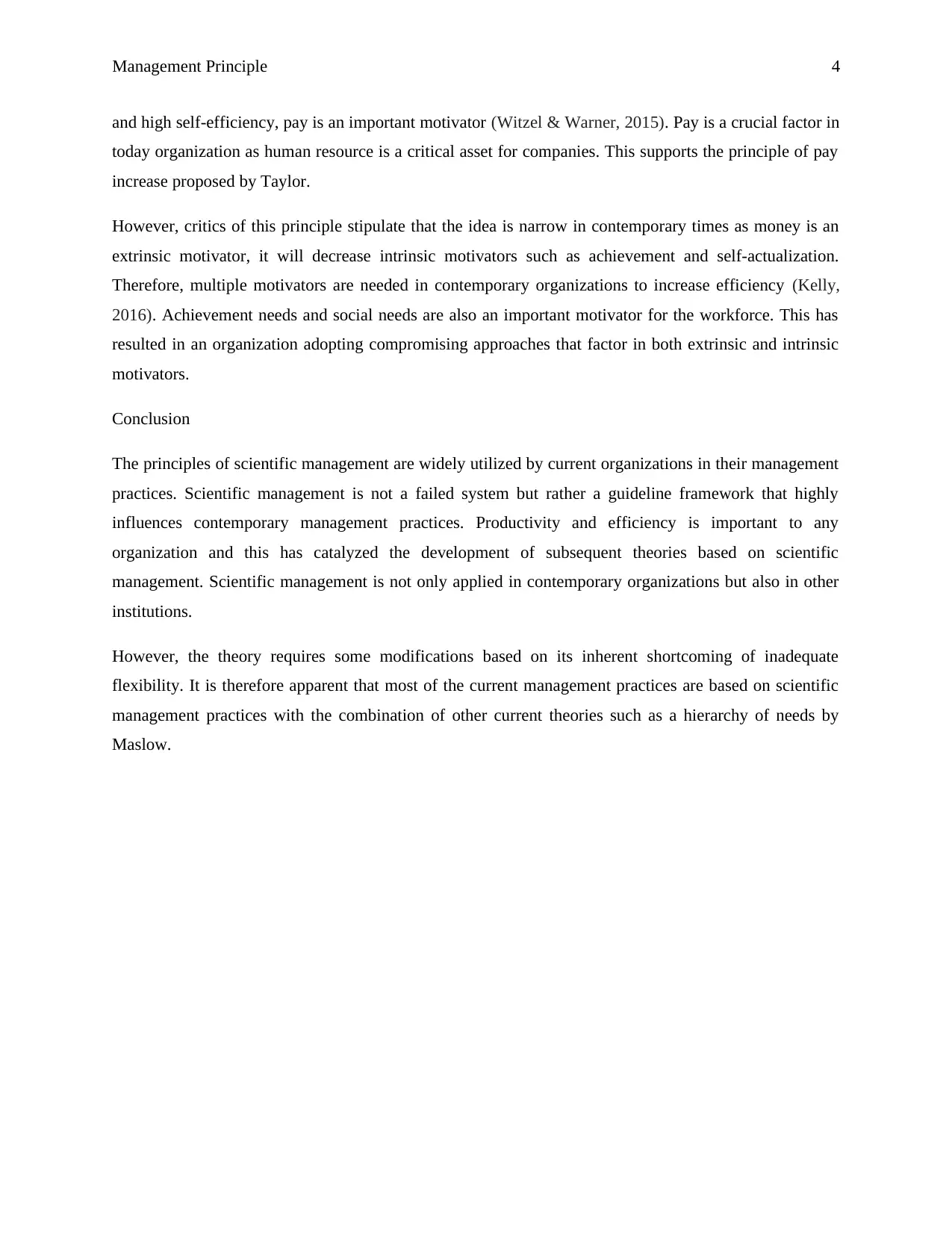
Management Principle 4
and high self-efficiency, pay is an important motivator (Witzel & Warner, 2015). Pay is a crucial factor in
today organization as human resource is a critical asset for companies. This supports the principle of pay
increase proposed by Taylor.
However, critics of this principle stipulate that the idea is narrow in contemporary times as money is an
extrinsic motivator, it will decrease intrinsic motivators such as achievement and self-actualization.
Therefore, multiple motivators are needed in contemporary organizations to increase efficiency (Kelly,
2016). Achievement needs and social needs are also an important motivator for the workforce. This has
resulted in an organization adopting compromising approaches that factor in both extrinsic and intrinsic
motivators.
Conclusion
The principles of scientific management are widely utilized by current organizations in their management
practices. Scientific management is not a failed system but rather a guideline framework that highly
influences contemporary management practices. Productivity and efficiency is important to any
organization and this has catalyzed the development of subsequent theories based on scientific
management. Scientific management is not only applied in contemporary organizations but also in other
institutions.
However, the theory requires some modifications based on its inherent shortcoming of inadequate
flexibility. It is therefore apparent that most of the current management practices are based on scientific
management practices with the combination of other current theories such as a hierarchy of needs by
Maslow.
and high self-efficiency, pay is an important motivator (Witzel & Warner, 2015). Pay is a crucial factor in
today organization as human resource is a critical asset for companies. This supports the principle of pay
increase proposed by Taylor.
However, critics of this principle stipulate that the idea is narrow in contemporary times as money is an
extrinsic motivator, it will decrease intrinsic motivators such as achievement and self-actualization.
Therefore, multiple motivators are needed in contemporary organizations to increase efficiency (Kelly,
2016). Achievement needs and social needs are also an important motivator for the workforce. This has
resulted in an organization adopting compromising approaches that factor in both extrinsic and intrinsic
motivators.
Conclusion
The principles of scientific management are widely utilized by current organizations in their management
practices. Scientific management is not a failed system but rather a guideline framework that highly
influences contemporary management practices. Productivity and efficiency is important to any
organization and this has catalyzed the development of subsequent theories based on scientific
management. Scientific management is not only applied in contemporary organizations but also in other
institutions.
However, the theory requires some modifications based on its inherent shortcoming of inadequate
flexibility. It is therefore apparent that most of the current management practices are based on scientific
management practices with the combination of other current theories such as a hierarchy of needs by
Maslow.
Paraphrase This Document
Need a fresh take? Get an instant paraphrase of this document with our AI Paraphraser
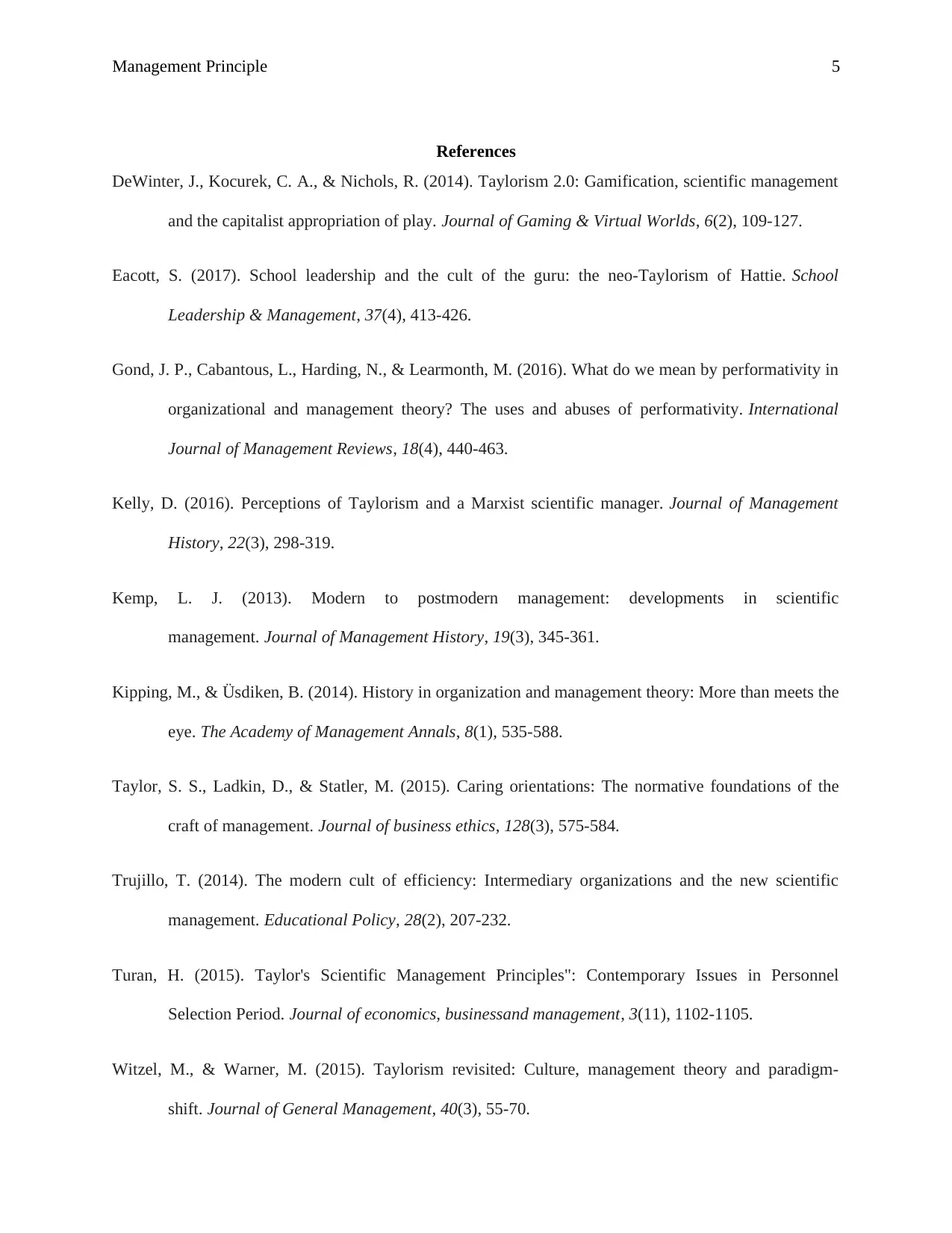
Management Principle 5
References
DeWinter, J., Kocurek, C. A., & Nichols, R. (2014). Taylorism 2.0: Gamification, scientific management
and the capitalist appropriation of play. Journal of Gaming & Virtual Worlds, 6(2), 109-127.
Eacott, S. (2017). School leadership and the cult of the guru: the neo-Taylorism of Hattie. School
Leadership & Management, 37(4), 413-426.
Gond, J. P., Cabantous, L., Harding, N., & Learmonth, M. (2016). What do we mean by performativity in
organizational and management theory? The uses and abuses of performativity. International
Journal of Management Reviews, 18(4), 440-463.
Kelly, D. (2016). Perceptions of Taylorism and a Marxist scientific manager. Journal of Management
History, 22(3), 298-319.
Kemp, L. J. (2013). Modern to postmodern management: developments in scientific
management. Journal of Management History, 19(3), 345-361.
Kipping, M., & Üsdiken, B. (2014). History in organization and management theory: More than meets the
eye. The Academy of Management Annals, 8(1), 535-588.
Taylor, S. S., Ladkin, D., & Statler, M. (2015). Caring orientations: The normative foundations of the
craft of management. Journal of business ethics, 128(3), 575-584.
Trujillo, T. (2014). The modern cult of efficiency: Intermediary organizations and the new scientific
management. Educational Policy, 28(2), 207-232.
Turan, H. (2015). Taylor's Scientific Management Principles": Contemporary Issues in Personnel
Selection Period. Journal of economics, businessand management, 3(11), 1102-1105.
Witzel, M., & Warner, M. (2015). Taylorism revisited: Culture, management theory and paradigm-
shift. Journal of General Management, 40(3), 55-70.
References
DeWinter, J., Kocurek, C. A., & Nichols, R. (2014). Taylorism 2.0: Gamification, scientific management
and the capitalist appropriation of play. Journal of Gaming & Virtual Worlds, 6(2), 109-127.
Eacott, S. (2017). School leadership and the cult of the guru: the neo-Taylorism of Hattie. School
Leadership & Management, 37(4), 413-426.
Gond, J. P., Cabantous, L., Harding, N., & Learmonth, M. (2016). What do we mean by performativity in
organizational and management theory? The uses and abuses of performativity. International
Journal of Management Reviews, 18(4), 440-463.
Kelly, D. (2016). Perceptions of Taylorism and a Marxist scientific manager. Journal of Management
History, 22(3), 298-319.
Kemp, L. J. (2013). Modern to postmodern management: developments in scientific
management. Journal of Management History, 19(3), 345-361.
Kipping, M., & Üsdiken, B. (2014). History in organization and management theory: More than meets the
eye. The Academy of Management Annals, 8(1), 535-588.
Taylor, S. S., Ladkin, D., & Statler, M. (2015). Caring orientations: The normative foundations of the
craft of management. Journal of business ethics, 128(3), 575-584.
Trujillo, T. (2014). The modern cult of efficiency: Intermediary organizations and the new scientific
management. Educational Policy, 28(2), 207-232.
Turan, H. (2015). Taylor's Scientific Management Principles": Contemporary Issues in Personnel
Selection Period. Journal of economics, businessand management, 3(11), 1102-1105.
Witzel, M., & Warner, M. (2015). Taylorism revisited: Culture, management theory and paradigm-
shift. Journal of General Management, 40(3), 55-70.
1 out of 5
Related Documents
Your All-in-One AI-Powered Toolkit for Academic Success.
+13062052269
info@desklib.com
Available 24*7 on WhatsApp / Email
![[object Object]](/_next/static/media/star-bottom.7253800d.svg)
Unlock your academic potential
Copyright © 2020–2025 A2Z Services. All Rights Reserved. Developed and managed by ZUCOL.





